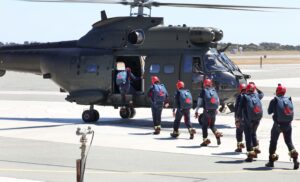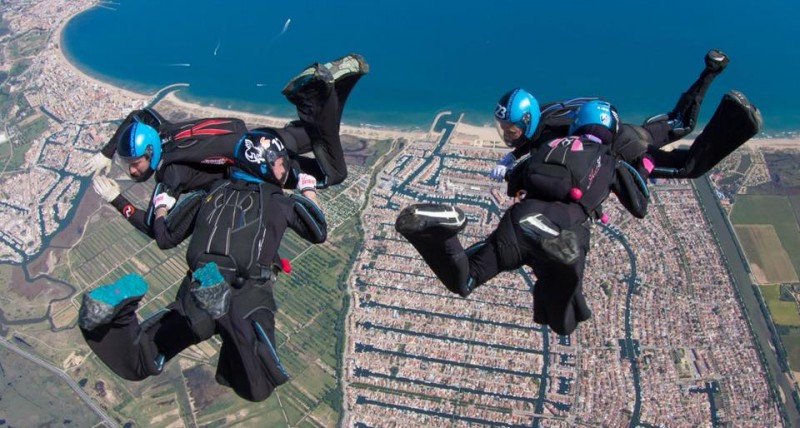Images courtesy of RAF Falcons
Have you ever seen a Falcon fly? How about fall?
The RAF Falcons have been falling for a long time, and it’s safe to say they’ve elevated it to a fine art. This 2024 display season is their 63rd, kicked off with some training in the southern California sunshine to put the gloss on some fresh manoeuvres in preparation for the team’s much-anticipated April kickoff. The season will see the team perform more than 60 displays – all over the UK, of course, but also across Europe, including the Formula 1 Grand Prix, the Slovakian International Air Show and France’s LAVAL Aeroshow in France.
Suffice it to say, it’s going to be another landmark season.
ANATOMY OF A DISPLAY JUMP
For those of us who tend to frequent the same handful of dropzones, it’s hard to imagine what it might be like to execute a complicated jump in brand-new-to-us skies. For a Falcon, that kind of novelty is a fact of life.
There’s a science to it, of course, and a process. Any new manoeuvres planned for a given display would initially be practised on the team’s second winter training exercise, Ex Falcon Stack – first, in small groups or three or four, adding more parachutists in stages until the full team is represented. Over the course of the exercise, the Falcons will workshop the manoeuvre around 120 times – and then again for another 20 jumps or so on UK soil before starting the display season.
A few hours before each display, the team’s Dropzone Safety Officer ticks through a safety checklist to make sure the conditions are appropriate; at t-minus 30 minutes, the DZSO releases a met balloon to get a real-time check on the winds from surface to despatch altitude (so that a suitable release point can be calculated). Only then is the team given the green light to jump.
From there, it’s a matter of executing on the training. A typical display is conducted from 7,000ft; of that, only around 2,000 are dedicated to freefall, because the team’s canopy showpersonship is the focal point: the “heart”, “criss-cross carousel” and “sabre chase” manoeuvres the team is known for. Even then, the show isn’t over until long after landing: there are crowd interactions, Q&A time and packing demonstrations still to do.
If you’ve ever done a high-stakes jump, you know how challenging it can be to navigate and manage all the personal and environmental factors with a smile. The Falcons do it with an audience, too – and they love it.

TEAM HISTORY
The team formed originally in 1961 – coincidentally, the same year as the first version of what is now the Golden Knights. That year, parachutists from the Parachute Training School at RAF Abingdon (going by the tongue-in-cheek moniker “The Big Six”, as all of them clocked in at five-foot six and shorter) started to experiment with what they could do in the sky as a team. Their physical stature may have been on the unimpressive side, but their guts sure weren’t: these were the first skydivers to jump from large military aircraft, when the going wisdom was that anybody foolish enough to exit from the ramp would be sucked back by the turbulence. Four years later, they had effectively become pioneers of the practice, their numbers growing to a dozen by 1965. By 1968, they were performing for the Queen.
The team decided that they needed a name to perform under. They chose their titular bird after heavy consideration; eventually, it was the dictionary definition of falcon that won them over. “Known for falling extremely rapidly,” so it went, “and much given to aerobatics, and swift swooping flight.”
And so they did. From Vancouver to Hong Kong, Oz to Sharjah (and absolutely all over the UK), the Falcons invented new ways to dazzle, breaking records and setting precedents as they went. They even brought around their own falcon for a while. His name was Fred.
Today, the Falcons operate as a sub-team within the Airborne Delivery Wing at RAF Brize Norton. There are even more Falcons now: fourteen members currently wear the badge – of which ten are display parachutists, one is a Dropzone Safety Officer, two are Survival Equipment Technicians (who maintain the fleet of parachutes, naturellement) and one manages the team. Commanding Officer Flt Lt Jen Littler helms, aided by the team’s coach, Flight Sergeant Liam Lyons.

FALCON LIFE
The RAF Falcons all joined the RAF initially as either Physical Training Instructors or Personnel Training Officers. After conducting basic and phase two training, they undergo rigorous selection to become Parachute Jump Instructors (PJIs). After selection, they complete the PJI course, then jump a variety of both static line and freefall parachute systems before learning to instruct and dispatch each in turn.
It’s only after they’re qualified on the full range of systems that they’re eligible to join the Falcons. Once on the team, the training continues: freefall; canopy flight; equipment; public relations. (They’re airborne ambassadors of the Royal Air Force, of course, and the team is known for its excellent bedside manner after every all-smiles landing.)
“We love seeing kids get excited to watch us,” says team member Flt Lt Alice Rogers. “It is particularly lovely to see young girls be inspired by us, as we now have two females in the team. I think the RAF is often sold to people by our aircraft and the dream of becoming a pilot, so it’s wonderful to hear young girls say they want to grow up and be a parachutist.”
“I often tell them to do the things that scare them,” Alice continues, “because that is exactly what I did, and I am now in a job that I love. We don’t get many girls coming down this route and I’d like to see that change in the future, so hopefully I am doing my bit towards that mission.”
Despite the emphasis on performance, it’s good to keep in mind that the Falcons aren’t run as a stable of show ponies. Since the Airborne Delivery Wing is a specialist parachute training facility to the wider Airborne Forces Community, the RAF Falcons as a team itself acts as a training pathway for RAF parachuting instructors. After a three-year tour as Falcons, former teammates go on to support specialist operational units as Military AFFIs – albeit Military AFFIs with great campfire stories. They also take part in various charity events throughout the year, raising awareness and funds to support the causes that matter most to them.
The team are constantly looking for ways to evolve their training and improve wherever they can: this season, by leveraging a camera flyer on every single display and practice jump, unlocking the team to conduct even more in-depth debriefs.

FIND THE FALCONS
To see the full 2024 display calendar and find out if the team are jumping near you, head to the RAF Falcons social media pages.
The RAF Falcons are supported each year by a range of loyal sponsors. Sponsoring the team for the 2024 season are Revolution Race, Bremont, Emergency Medical and Fire Solutions, Summit Air, ASF Signs, Sonic Communications, Cypres and the RAF Benevolent Fund.
Want to find more stories like this? Download the official Skydive the Mag app on either apple or android. Don’t want to download? Don’t worry. You can read the online version here.





